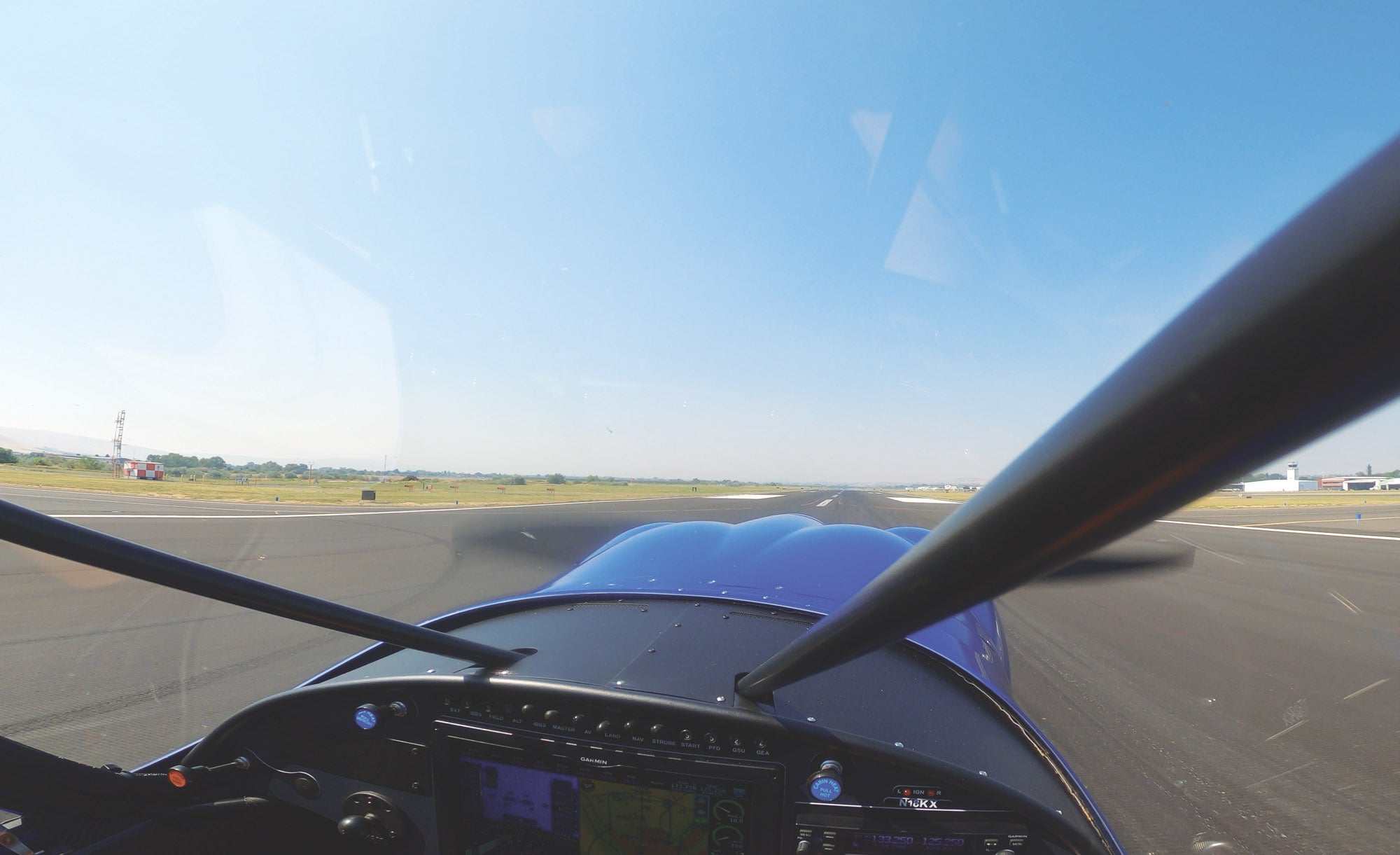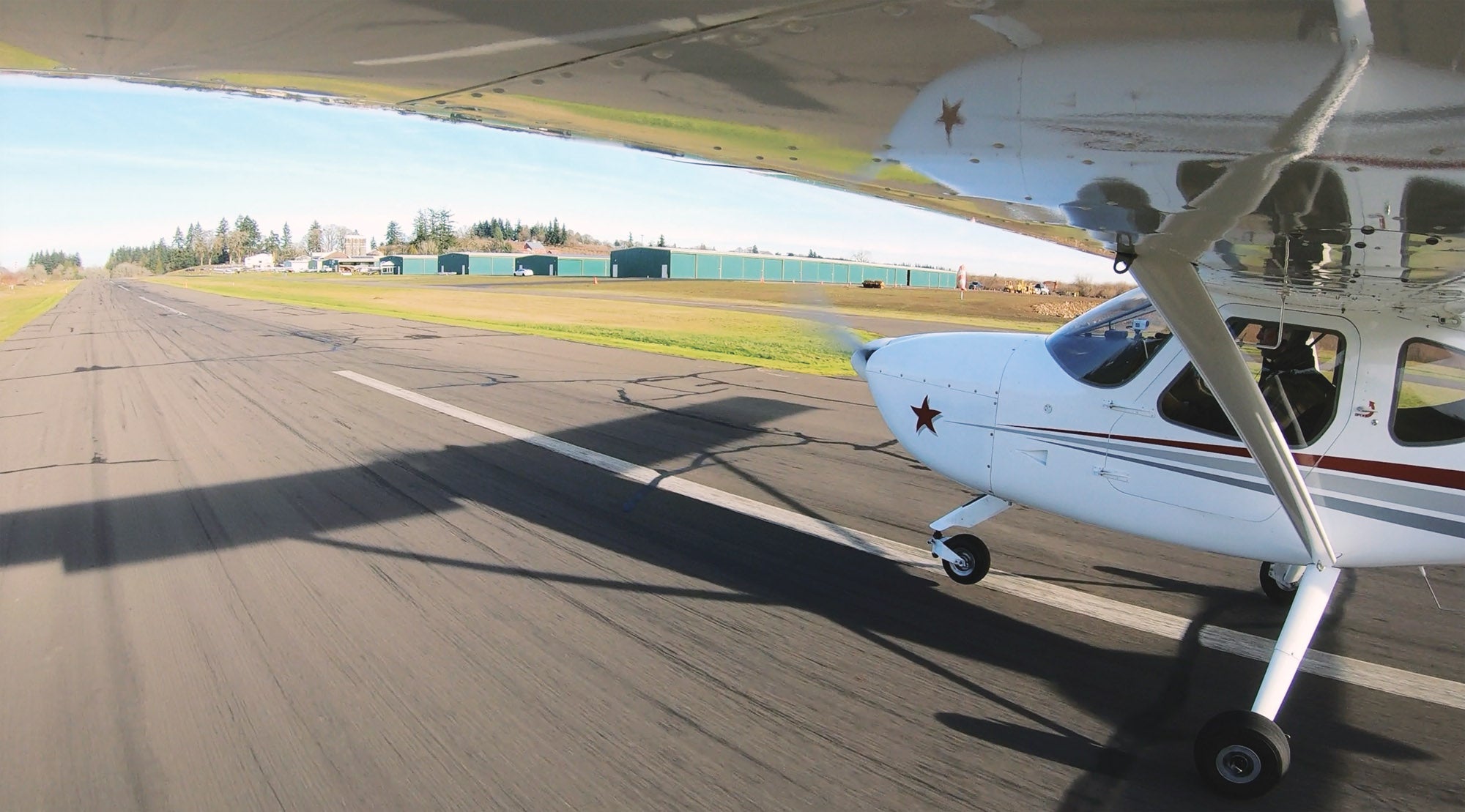
Once the airplane has been powered up and static testing of its systems is complete it is time to move on to taxi tests. Taxi testing starts when the airplane first moves under its own power and ends when the airplane is determined to be ready for its first up-and-away flight.
Slow Taxi
The first phase of taxi testing is done at low speed on the ramp or taxiway no faster than normal taxi speeds. Engine power is low, never more than what is needed to move the airplane at walking pace or slightly faster. Higher-power testing will happen later, on the runway.
These tests will be the first prolonged operation of the airplane with the vibration from the engine. After each excursion, it is a good idea to check linkages and fasteners for tightness and security and ensure nothing is coming loose from the engine vibration.
During low-speed taxi testing, the airspeed is slow enough so that the aerodynamic controls are relatively ineffective. Low-speed taxi operations are valuable to verify the characteristics of the landing gear and the ground handling of the airplane. Steering on the ground, directional stability while rolling, the structural stability and stiffness of the landing gear and the effectiveness of the brakes can all be verified and the landing gear and steering mechanisms adjusted or modified as necessary.
The initial low-speed taxi tests also provide the pilot with an opportunity to become familiar with the cockpit environment and operation of the controls, as well as the sight picture from the pilot seat.
Faster Taxi Tests
Once the initial low-speed taxi tests are complete and any issues that were raised are corrected, it’s time for testing to move onto the runway for higher-speed tests. In these medium-speed and high-speed tests, the airplane will do multiple runs down the runway at progressively higher speeds to get ready for first flight.
Every program I have participated in has had a hard rule that the airplane does not go on the runway unless it is fully prepared to fly. It is critical that the airplane be flight-ready even if the test plan does not include liftoff or flight. This means that the airplane must be fully assembled, all fasteners safetied and all of the safety-critical systems needed for a safe first flight are completely functional. Both plane and pilot must be prepared to fly if circumstances force an unplanned flight.
There are several situations in which this becomes safety-critical. An incompletely assembled airplane can be dangerous for multiple reasons. I’m personally aware of two such situations that led to accidents. In the first, a builder decided to fast-taxi a canard airplane with the canard installed but without wings. The intent was to test the engine and steering at a higher power and speed than was safe on the taxiway. Unfortunately, the plane got going fast enough that the canard lifted the nosewheel off the ground. Without the lift of the (missing) wings to balance the lift of the canard, the airplane flipped over backward and ended up inverted on the runway.
In another case, a prototype had a temporary control linkage installed so the controls would move properly when the not-yet-flown airplane was displayed at a show. Unfortunately, this linkage was not replaced before the airplane got on the runway, and in an apparently unplanned first flight, the temporary linkage failed with disastrous results.

Unintentional First Flights
Even when the test plan does not include a liftoff, it’s possible for the airplane to end up in a situation where flying is the safest thing to do. A famous example of this is the first flight of the prototype YF-16 fighter. During a high-speed taxi test, the airplane got into a diverging roll oscillation caused by a combination of sensitive lateral stick control and landing gear dynamics. The pilot had the presence of mind and skill to decide to lift off and fly. Once off the ground without the landing-gear dynamics, the plane was controllable and the pilot was able to make a safe circuit of the airport and landing. Later this was re-designated “flight zero” once the airplane, with revised roll-control gains in the flight control system, made its “official” first flight.
Flying away may also be the best option if the airplane is going too fast, too far down the runway, to stop safely. This can happen after a liftoff in ground effect followed by floating, a delay retarding the throttle until farther down the runway than planned or poorer than expected braking. A runway incursion by people, animals or a vehicle can leave taking off and flying over the suddenly appearing obstacle as the safest option. What is common in all of these scenarios is a rapidly developing situation where the pilot must make a quick decision. Both the plane and the pilot should be flight-ready so that taking off safely is possible.
Test Procedure
All aircraft testing, including taxi tests, requires planning and discipline. Each run should be planned. The pilot should execute only the predetermined profile and not improvise or try to do more. The taxi tests are a series of runs down the runway. They start at speeds slightly above normal taxi speed and ideally build up to at least takeoff rotation speed.
Each test run follows essentially the same sequence. Before going onto the runway, ensure the airplane is configured for the planned run, then:
Line up and wait: Taxi onto the runway and line up on the centerline.
Brake release: Release the brakes and smoothly apply power. The power level will vary depending on the run plan. Early runs will be at reduced power. Later, faster runs will use full power to accelerate.
Track centerline and accelerate to target speed: During the acceleration phase of the run, the pilot holds the controls steady, making only those control inputs needed to hold attitude and track the runway centerline.
Reduce power: When the airplane gets to the target speed, the pilot should either reduce power to hold speed or pull the throttle to start coasting down. The goal here is to ensure that the airplane does not continue to accelerate during the controls exploration to follow.
Make planned control inputs and observe response: With the speed stabilized, the pilot can now perform the specific controls exploration for this run.
Decelerate and exit runway: Reduce power to idle if it is not already there, neutralize the controls and brake as needed to slow or stop. Exit the runway.
The first thing to verify in medium- to high-speed taxi tests is the pilot’s ability to control the airplane directionally and track the runway centerline both during acceleration and braking. During these first runs, also evaluate the acceleration of the airplane to start determining how long the takeoff roll is likely to be and verify the airplane has enough power to accelerate to liftoff speed and climb.
Once the pilot is confident that they can control the airplane directionally, the tests move on to making specific control inputs to evaluate the characteristics of the flight-control surfaces. These tests evaluate effectiveness of the controls, as well as the forces the pilot feels through the stick and rudder pedals. Be especially alert for nonlinear control forces or any time stick force goes down with increasing deflection. Stick-force reversal can be particularly dangerous and must be corrected before flying.
If a taxi run reveals a deficiency, a surprise or any unexpected behavior from the airplane it is critical to address it immediately. Do not go any faster until you understand and resolve the issue. Also resist the temptation to test other things in the meantime. The urge to “just try a little harder” or “go a little faster just to see” has caused serious accidents.
It is also important to resist the temptation to try for a quick fix. Two common mistakes are to blindly implement a “standard” modification to fix the problem and assume it’s fixed or to make multiple changes at once in an attempt to fix it faster. There have been multiple accidents that happened when a builder made several large changes simultaneously to correct a problem, assumed it was fixed and found out the hard way that not only had they not fixed the problem, they had made it worse.
The safe path is methodical. Analyze and evaluate the data taken in the taxi test. If it is safe to do so, repeat the taxi test in exactly the same conditions as when the issue was first found. The goal is to verify the original finding. Do not go faster or try the “next thing” on a repeat run.
Once you understand the source of the problem, or at least have a reasonable working theory as to its cause, you can plan a series of progressive modifications and taxi runs, working up to the same conditions where the original runs found the issue. It is only safe to resume the original test program and move on to testing at higher speed after the airplane is able to perform a successful run with the issue resolved under the same conditions where it first appeared.
High-Speed Taxi Tests
There is a decision point in a test program when taxi test speed approaches either the stall speed or rotation speed of the airplane. The amount of runway needed to accelerate to condition, test and then safely stop increases with the square of the speed. As the runs get faster, runway length becomes critical. There are three possible fast-taxi test paths, and all can be used successfully:
No nosewheel liftoff until ready to fly. In this case, the airplane does not exceed stall speed during taxi test. The first rotation is intended to be for takeoff for the first flight.
Establish nosewheel liftoff speed in taxi test. The fastest taxi speed in this case is above rotation speed but below liftoff speed. The goal on the fastest taxi test is to establish rotation speed by using the elevators to rotate to a takeoff attitude, but not to lift off.
Lift off and hop in ground effect. In this approach the highest-speed “taxi” tests are actually low-altitude hop flights down the runway.
The choice of which plan is appropriate depends on the details of the test program. The right way to proceed depends on the speed and wing loading of the airplane, the amount of runway available and the type of propulsion. In the extreme example, high-wing-loading jets behave very differently than a low-wing-loading piston-powered airplane like an ultralight or Cub.
Next time, we will take a look at the final high-speed taxi tests and initial liftoff.














I look forward to every one of your posts. If you’re ever on the west coast look me up at KLVK. I’d love to buy you a beer and hear your stories.